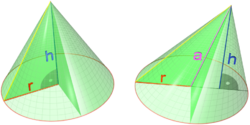Partial derivative
In multivariable calculus, the partial derivative of a function is the derivative of one variable when all other variables are held constant. In other words, a partial derivative takes the derivative of certain variables of a function while not differentiating other variable(s). Partial derivatives are often used in multivariable functions.
For partial derivatives of function f with respect to variable x, the notation
[math]\displaystyle{ \frac{\partial f}{\partial x} }[/math], [math]\displaystyle{ f_x }[/math], [math]\displaystyle{ \partial_x f }[/math]
is standard,[1][2][3] but other notations are sometimes used.
Examples
If we have a function [math]\displaystyle{ f(x, y)=x^2+y }[/math], then there are several partial derivatives of f(x, y) that are all equally valid. For example,
- [math]\displaystyle{ \frac{\partial }{\partial y}[f(x, y)]=1 }[/math]
Or, we can do the following:
- [math]\displaystyle{ \frac{\partial}{\partial x}[f(x, y)]=2x }[/math]
Partial Derivative Media
Related pages
References
- ↑ "List of Calculus and Analysis Symbols". Math Vault. 2020-05-11. Retrieved 2020-09-16.
- ↑ Weisstein, Eric W. "Partial Derivative". mathworld.wolfram.com. Retrieved 2020-09-16.
- ↑ "Calculus III - Partial Derivatives". tutorial.math.lamar.edu. Retrieved 2020-09-16.
